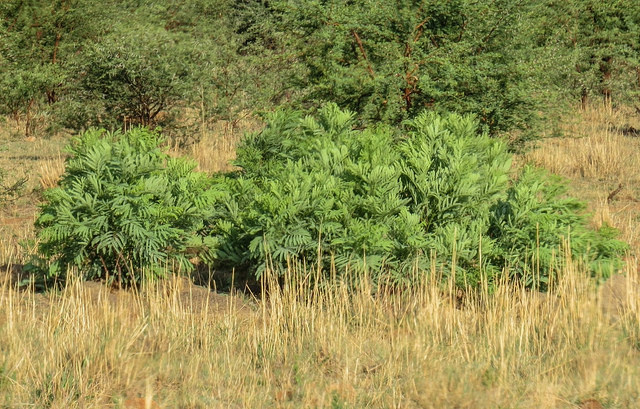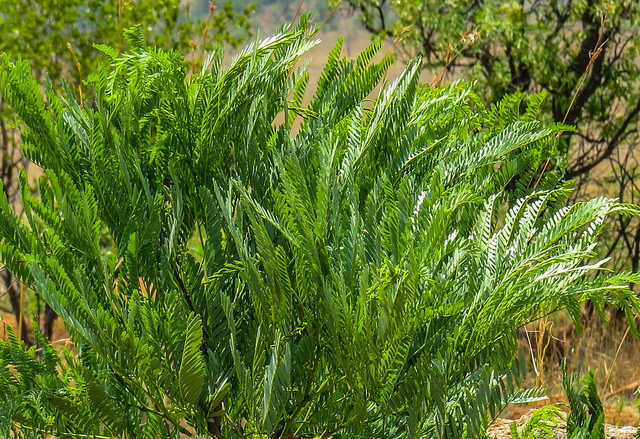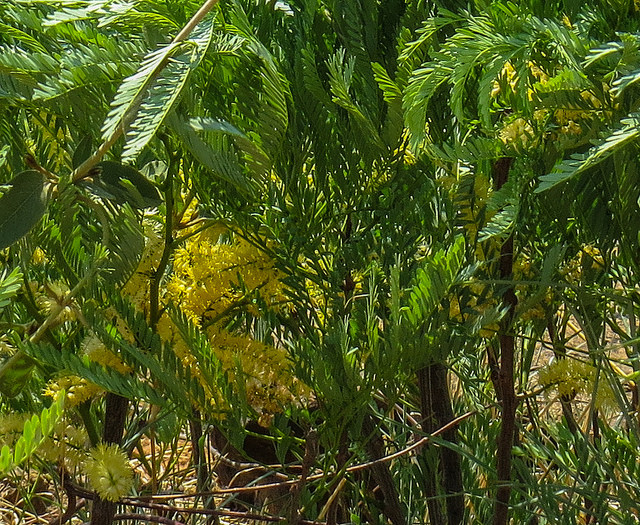176.
Black Thorn Acacia Senegalia mellifera, Acacia mellifera (Swarthaak)
Order: Fabales. Family: Fabaceae. Subfamily: Mimosoideae

© nan

© nan
Kgalagadi Transfrontier Park, Nossob
Description
A very thorny multi-stemmed small tree or shrub with a rounded or spreading flat crown that sometimes touches the ground, 3–7 m tall.
Thorns occur in pairs at nodes which are spaced at intervals of 5–15 mm, sometimes up to 30 mm. There are thus more thorns per unit length of branch than with other species. The thorns are hooked and blackish. Short, curved thorns, like cats’ claws, are found just below each leaf-bud, and spiral around the branchlets and twigs. They are yellow-green when young and dark red to grey-black when mature. This tree has more thorns per length of stem than most Acacias (Thorn: up to 5 mm).
The leaves are twice compound and have 2-3 pairs of feathers, and are unusual for an Acacia, each leaflet having only 1–2 pairs of large, opposite leaflets. Each pair looks like a butterfly (Leaflet: 4–15 x 3–10 mm). Leaves are green initially, the same shade both above and below, but become glaucous when older. Main and lateral venation is visible on both surfaces. Leaflet margins are sparsely fringed with white hairs. The combined length of petiole (leaf stalk) plus rachis (the axis of a compound leaf) is up to 40 mm long. This stalk is sparsely pubescent, though sometimes glabrous on young plants, and is slender and light green. A petiole gland is usually present; the petiole is hairy.
The bark is rough and dark brown to black on the main stem and older branches, with lengthwise fissures showing yellowish under-bark. On the young branches the bark is grey to yellowish-brown.
Flowers usually appear in August or September before the tree comes into leaf. The conspicuous flowers look like balls but are actually very short flower-spikes. They are closely packed along the rigid, dark brown branchlets (10 mm diam.) The flowers are cream to white, but they take on a brownish hue when fading. They are sweetly scented.
The pods develop rapidly after flowering has taken place. They are small, straw-coloured or pale brown, thin to almost papery, straight, smooth, dehiscent (opening spontaneously when ripe) and 25–80 x 13–25 mm (January–April).
Distribution
From the Northern Cape in the south, to the Free State, Gauteng, North-West Province, Mpumalanga, the Limpopo Province, and northwards to Tanzania. In the Northern Cape Province it occurs mainly in the northwestern portion, notably in the Vryburg, Taung, Barkly West and Keimoes areas. In the Free State it grows in the western portion: Jacobsdal and Fauresmith areas. In Gauteng, Limpopo, Mpumalanga and North West Provinces: it is found over most of the bushveld areas, down to the Springbok Flats north of Pretoria.
In Namibia it is found in the Caprivi Strip, Kaokoveld, Otjiwarongo, Outjo, Okahandja and Gobabis Districts and further south. In Botswana it occurs in the eastern and southern regions.
Habitat
In bushveld, dry woodland, arid savanna and semidesert areas, often on Kalahari sand and often growing in circular groups forming impenetrable thickets in overgrazed areas. It prefers deep sandy or gravelly soils and puts down a very deep tap-root.
Links:
Sappi Tree Spotting: Bushveld, Including Pilanesberg and Magaliesberg









 © nan
© nan © nan
© nan


 © nan
© nan © nan
© nan





 © steamtrainfan
© steamtrainfan © steamtrainfan
© steamtrainfan © steamtrainfan
© steamtrainfan